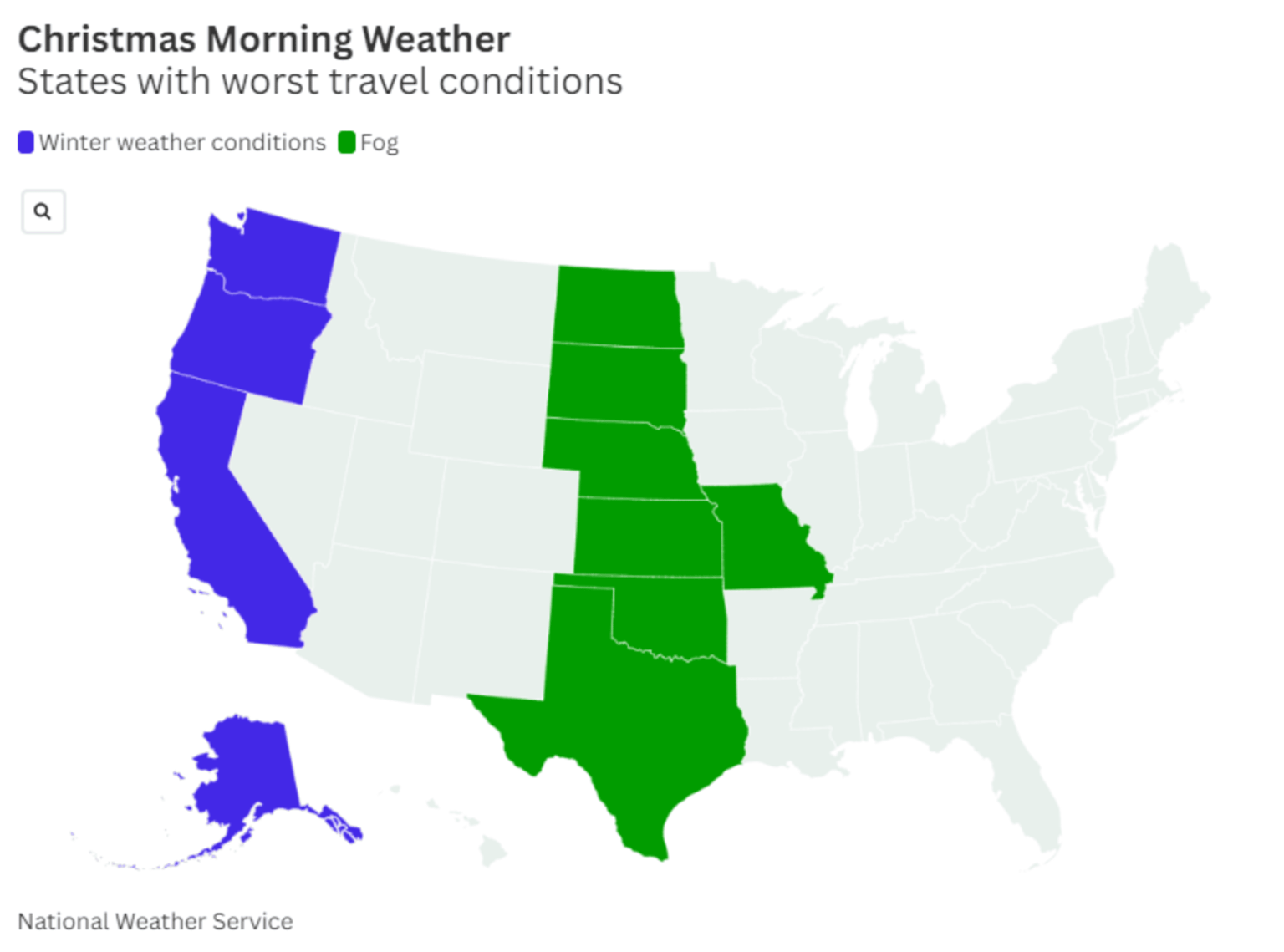The Christmas holiday travel season is underway, with millions of Americans hitting the roads and airways to celebrate with loved ones. While many embarked on their journeys over the weekend, those setting out on Christmas morning are facing a mixed bag of weather conditions, some potentially treacherous. The National Weather Service (NWS) has issued alerts across the country, highlighting areas where travel could be significantly impacted. Dense fog blankets a large swathe of the central U.S., stretching from North Dakota down to Texas, reducing visibility and creating hazardous driving conditions. In the Northwest, an atmospheric river is bringing heavy snow and rain, with Washington, Oregon, and California bracing for significant impacts. Further complicating the holiday travel picture are impending winter storms forecast for Montana, Idaho, and Wyoming, threatening to disrupt return journeys for those heading home after Christmas. Alaska, too, is grappling with winter weather alerts, including heavy snow and dangerously cold wind chills.
The widespread dense fog advisory across the central U.S. poses a significant threat to drivers. With visibility drastically reduced to less than a quarter of a mile in some areas, the NWS urges caution, recommending reduced speeds, the use of headlights, and maintaining a safe following distance. The fog is also expected to deposit a thin layer of ice on surfaces, further increasing the risk of accidents. While these advisories are expected to lift by Wednesday afternoon, providing some relief for Christmas Day travel, the improving conditions are counterbalanced by deteriorating weather in other parts of the country.
The Pacific Northwest is facing a renewed onslaught of heavy snow and rain as an atmospheric river gains strength. Washington and Oregon are expected to bear the brunt of the storm by late Wednesday afternoon, with California anticipating impacts later in the evening. The NWS warns of potential travel disruptions, with heavy snowfall making roads impassable in some areas. Strong winds accompanying the storm also pose a threat, potentially bringing down tree branches and power lines. The storm is forecast to continue through the weekend, possibly dumping up to 12 inches of rain or snow in parts of California, creating challenging conditions for post-holiday travel.
As the Pacific Northwest grapples with the intensifying storm, parts of the Northern Rockies and the Plains are preparing for their own winter weather onslaught. Northern Montana and northern Idaho are under winter storm watches, with heavy snow expected to begin Thursday morning, potentially impacting those returning home after Christmas. Wyoming is anticipating high winds beginning on Thursday, adding another layer of complexity to holiday travel. These developing storms further underscore the need for travelers to remain vigilant and check weather forecasts before embarking on their journeys.
Alaska is experiencing a harsh winter blast, with multiple weather warnings in effect. Heavy snow is expected to cause travel disruptions, while dangerously cold wind chills as low as -35°F pose a significant risk of frostbite. The NWS advises against unnecessary travel in affected areas, warning that exposed skin can freeze in as little as 10 minutes under such extreme conditions. This frigid weather further complicates the holiday travel picture, highlighting the diverse and challenging conditions across the country.
The NWS is urging travelers to stay informed about weather conditions and heed local advisories. Checking the latest forecasts and alerts from local NWS offices is crucial for making informed travel decisions. For those in areas impacted by dense fog, caution is paramount, with reduced visibility creating hazardous driving conditions. In the Pacific Northwest, travelers should be prepared for significant disruptions due to heavy snow and rain, potentially impacting both holiday and post-holiday travel. Those in Montana, Idaho, and Wyoming should also monitor forecasts closely as winter storms develop, potentially affecting return journeys. Finally, in Alaska, extreme cold and heavy snow require utmost caution, with travel strongly discouraged unless absolutely necessary.
The holiday travel season presents a complex interplay of weather conditions across the country, ranging from dense fog to heavy snow and extreme cold. By staying informed, heeding NWS advisories, and making informed decisions, travelers can navigate these challenges and ensure a safe and enjoyable holiday season. Flexibility and preparedness are key, especially given the dynamic nature of weather patterns. Checking forecasts regularly and being prepared for potential delays or disruptions will help mitigate the impacts of inclement weather and ensure a smoother travel experience.

